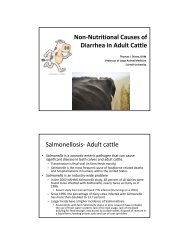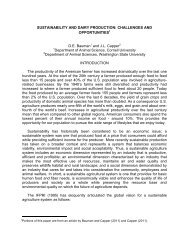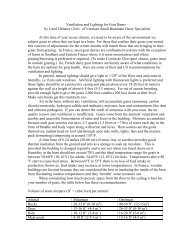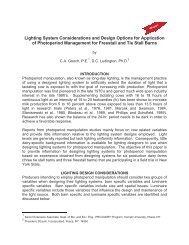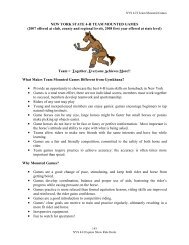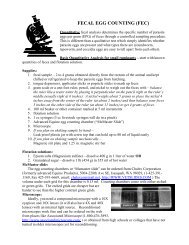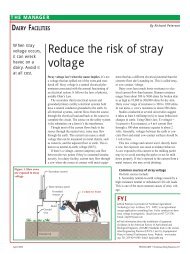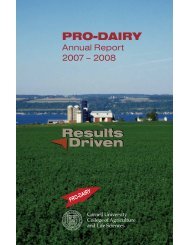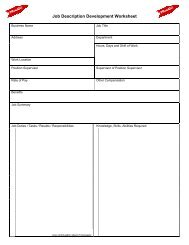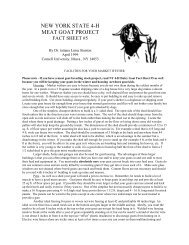2009 Proceedings of the Cornell Nutrition Conference For Feed ...
2009 Proceedings of the Cornell Nutrition Conference For Feed ...
2009 Proceedings of the Cornell Nutrition Conference For Feed ...
Create successful ePaper yourself
Turn your PDF publications into a flip-book with our unique Google optimized e-Paper software.
Milk Fat Yield as lbs<br />
2 80<br />
2.70<br />
2.60<br />
2 50<br />
2.40<br />
2 30<br />
2 20<br />
2.10<br />
2 00<br />
1 2 3 4 5 6 7 8 9 10 11 12<br />
Milk Fat Yield Oct-Dec 2007 2 21 2.25 2 32 2.20 2 30 2 32 2 28 2 37 2.40 2.45 2 51 2 58<br />
Milk Fat Yield Oct-Dec 2008 2 28 2.36 2.45 2.48 2.48 2 50 2.49 2 53 2.45 2.49 2 58 2 67<br />
Weeks <strong>of</strong> period Oct 1st through December 31st<br />
CONCLUSIONS<br />
The adoption <strong>of</strong> <strong>the</strong> concept <strong>of</strong> balancing diets for AA continues to increase.<br />
Balancing diets to come as close as possible to meeting model determined optimal<br />
concentrations <strong>of</strong> Lys and Met in MP is <strong>the</strong> first step to balancing diets for AA. Benefits<br />
include: 1) increased yield <strong>of</strong> milk and milk components, 2) reduced N excretion per unit<br />
<strong>of</strong> milk or milk protein produced, 3) more predictable changes in milk and milk protein<br />
production to changes in RUP supply, 4) improved herd health and reproduction, and 5)<br />
increased herd pr<strong>of</strong>itability. Increases in milk protein and fat concentrations <strong>of</strong> 0.1-0.25<br />
percentage units for protein and 0.1-0.15 for fat and returns on investment <strong>of</strong> 2.0 to 3.5<br />
are typical. Increases in milk yield are more common in early lactation cows than late<br />
lactation cows, and can be ra<strong>the</strong>r significant if balancing for Lys and Met is started<br />
before calving. With high feed costs and low milk prices, an important benefit <strong>of</strong> AA<br />
balancing has been <strong>the</strong> opportunity to increase milk and milk component yields with less<br />
RUP supplementation and similar or lower feed costs.<br />
REFERENCES<br />
Boucher, S. E., R. S. Ordway, N. L. Whitehouse, F. P. Lundy, P. J. Konon<strong>of</strong>f and C. G.<br />
Schwab. 2007. Effect <strong>of</strong> incremental urea supplementation <strong>of</strong> a conventional<br />
corn silage-based diet on ruminal ammonia concentration and syn<strong>the</strong>sis <strong>of</strong><br />
microbial protein. J. Dairy Sci. 90:5619-5633.<br />
Chen, J., G. Broderick, D. Luchini, B. Sloan, and E. Devillard. <strong>2009</strong>. Effect <strong>of</strong><br />
metabolizable lysine and methionine concentrations on milk production and N<br />
utilization in lactating dairy cows. J. Dairy Sci. 92 (Suppl. 1):171. (Abstr.)<br />
Driver, S. 2007. From concept to practice – experience in <strong>the</strong> USA. International Amino<br />
Acid Seminar – Belgium.<br />
13



